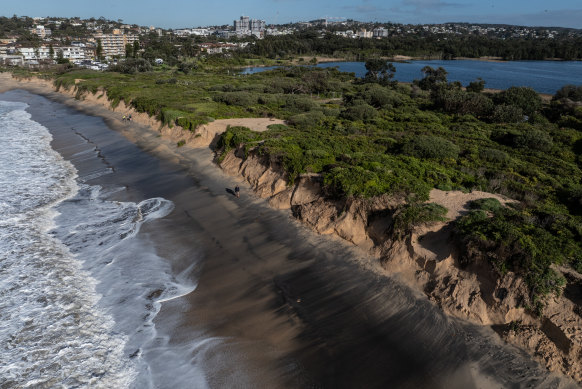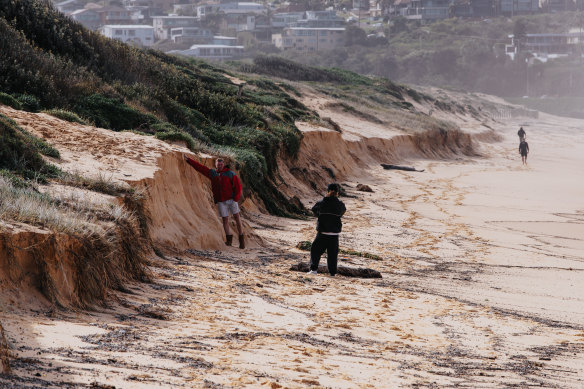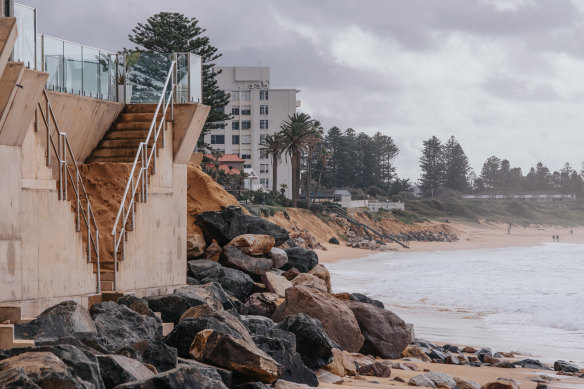‘Unusual’ winter swells erode Sydney beaches and sand dunes
By Caitlin Fitzsimmons
An unusually prolonged coastal storm has pummelled beaches from Sydney to Newcastle in the past week, causing sand dune erosion that could take years to recover.
Beaches facing south and south-east were most exposed to several days of strong southerly swells. Sydney’s northern beaches were among the worst hit.

Beach and sand dune erosion in Dee Why on Sydney’s northern beaches.Credit: Nick Moir
Beach erosion has damaged sand dunes at South Curl Curl and Dee Why, and eroded front yards along the Collaroy and Narrabeen waterfront. Sand is virtually non-existent under the controversial seawall built to protect multimillion-dollar homes in Collaroy.
Dr Mitchell Harley, an expert in coastal erosion at the University of NSW, said beaches from Eden to Coffs Harbour had lost sand, but the Sydney-Newcastle region had copped the brunt of the storm.
He said damaged sand dunes did not recover as easily as beaches did.
“If it’s just the dry part of the beach, it can recover quite rapidly,” Harley said. The rule of thumb was that, for every metre of sand lost on a beach, it would take five to 10 days to recover.

Erosion of sand dunes at South Curl Curl beach this week.Credit: James Brickwood
“But if it’s the dunes that are impacted, which is what we’ve seen in the last week or so, they take a lot longer to recover. They are rebuilt usually by the winds rather than waves and that’s a lot longer process – years rather than weeks to months.”
A European research paper published in Nature Climate Change in 2020 predicted that half the world’s beaches would disappear by 2100 because of rising sea levels, including 40 per cent of Australia’s 12,000 beaches.
An international team including researchers from the University of Sydney and the University of Wollongong published a rebuttal paper that said beaches with natural sand dunes would be able to retreat inland, retaining their general shapes. However, the paper said beaches such as Collaroy and Wamberal in NSW, backed by hard coastal cliffs or seawalls, would have nowhere to go, so the expanse of sand would shrink and eventually drown.

Erosion of private property along the Collaroy and Narrabeen beachfront.Credit: James Brickwood
In 2022, property owners, the Northern Beaches Council and the state government built a seawall along the beach front from Collaroy to South Narrabeen, including a seven-metre tall structure with stair access in front of private properties. Many local residents protested against the project, fearing it would worsen beach erosion.
While there was coastal erosion earlier this winter, Harley said the swell this week was “unusual though not unprecedented” in its duration. There were four days of waves above three metres and peaking up to 5.7 metres.
Olenka Duma from the Bureau of Meteorology also said the coastal storm, which developed on July 29 and peaked on August 1, had been unusually prolonged.

The private seawall filled with sand with beach erosion below along the Collaroy beachfront.Credit: James Brickwood
”We do often see these events across the winter months. It’s not unusual, but certainly [it being] this prolonged is probably a little bit more on the unusual side,” Duma said.
Duma said the “large, powerful seas” were caused by a low pressure system over the Tasman Sea, and a high system just off Tasmania, which were both quite stationary and driving strong southerly winds and swell along the NSW coast.
Beaches in the eastern suburbs got off lightly this time, but in Sutherland Shire, the large, powerful surf caused significant sand erosion at several beaches.
A council spokesperson said the seawalls at Prince Street and North Cronulla built in 2022 had held up, protecting coastal infrastructure, and further inspections would occur over the coming days.
Northern Beaches Council said in a statement it expected the beaches to recover following coastal storms, but council staff would undertake maintenance of natural dunes, replenishment of sand at beaches, and repairing seawalls where needed.
Get to the heart of what’s happening with climate change and the environment. Sign up for our fortnightly Environment newsletter.